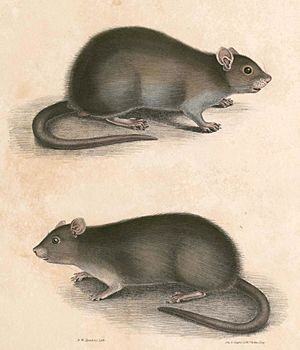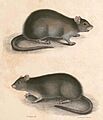Lesser bandicoot rat facts for kids
Quick facts for kids Lesser bandicoot rat |
|
|---|---|
 |
|
| Conservation status | |
| Scientific classification | |
| Kingdom: | |
| Class: | |
| Order: | |
| Family: | |
| Subfamily: | |
| Genus: |
Bandicota
|
| Binomial name | |
| Bandicota bengalensis Gray, 1835
|
|
The lesser bandicoot rat (Bandicota bengalensis) is a type of rodent that lives in southern Asia. These rats can grow quite large, up to 40 centimeters (about 16 inches) long, including their tail. Even though it's called a rat, it's not part of the common Rattus genus that many other rats belong to.
Lesser bandicoot rats are known to be a pest because they can damage cereal crops and gardens, especially in countries like India and Sri Lanka. When they feel threatened, they can make a grunting sound, a bit like a pig. Their fur is usually dark brown on their back and a lighter or darker gray on their belly. Their body is about 25 centimeters (10 inches) long, and their tail is shorter than their body.
Where They Live
Lesser bandicoot rats often live in different places, including fields, farms, and even empty houses in villages. They are very good at digging and can create complex burrows underground. These burrows help them stay safe and store food.
When these rats feel scared or threatened, they can become very aggressive. This is their way of defending themselves from danger.
Interesting Facts
Even though its name includes "bandicoot," the lesser bandicoot rat is actually not related to the bandicoot. A bandicoot is a type of marsupial, which means it's an animal that carries its young in a pouch, like a kangaroo. The lesser bandicoot rat, however, is a rodent, which is a completely different group of mammals.
The International Union for the Conservation of Nature (IUCN) keeps track of animal populations around the world. They have stated that there are many lesser bandicoot rats living across a wide area. Because of their large numbers, the IUCN has listed them as an animal of Least Concern for survival. This means they are not currently at risk of disappearing.
Images for kids
See also
 In Spanish: Rata bandicota menor para niños
In Spanish: Rata bandicota menor para niños



